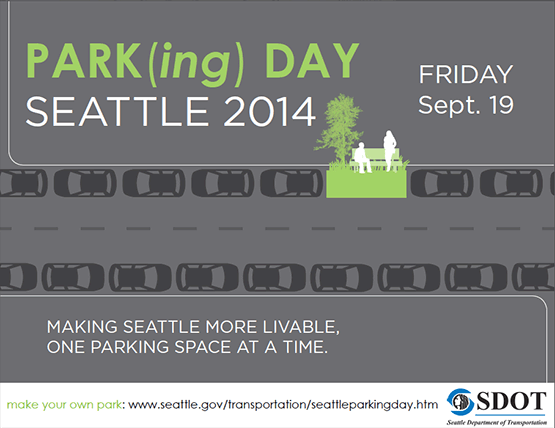PARK(ing) Day is right around the corner, and that means our city streets will soon see an extra splash of vibrancy–even if only for a day. On September 19, Seattle will celebrate its eighth year of sponsoring PARK(ing) Day events across the city. PARK(ing) Day, for the unfamiliar, is an international event that confronts the issue of how we use our limited right-of-way spaces. PARK(ing) Day poses two simple questions: Do we need to allocate so much infrastructure to on-street parking? Or could we use that space for other things like more trees, street vendors, parks, bicycle racks, or other public space?
Nearly a decade ago, the first PARK(ing) Day event was born in San Francisco by local design firm Rebar. They recounted why they embarked on an experiment to convert a parking space to a park in a very simple way:
Rebar’s original PARK(ing) project in 2005 transformed a single metered parking space into a temporary public park in an area of San Francisco that the city had designated as lacking public open space. The great majority of San Francisco’s downtown outdoor space is dedicated to movement and storage of private vehicles, while only a fraction of that space is allocated to serve a broader range of public needs. Paying the meter of a parking space enables one to lease precious urban real estate on a short-term basis. The PARK(ing) project was created to explore the the range of possible activities for this short-term lease, and to provoke a critical examination of the values that generate the form of urban public space.
Our original PARK stood in place for two hours–the term of the lease offered on the face of the parking meter. When the meter expired, we rolled up the sod, packed away the bench and the tree, and gave the block a good sweep, and left. A few weeks later, as a single iconic photo of the intervention traveled across the web, Rebar began receiving requests to create the PARK(ing) project in other cities. Rather than replicate the same installation, we decided to promote the project as an “open-source” project, and created a how-to manual to empower people to create their own parks without the active participation of Rebar. And thus “PARK(ing) Day” was born.
Last year, there were over 40 locations across the city that hosted a PARK(ing) Day event (many of which can be seen in the Flickr slideshow below). And this year, the Seattle Department of Transportation (SDOT) wants the program to be bigger and better than the last. There’s lots of ways to get involved in PARK(ing) Day to make it a huge success.
- Show up to any one of the many PARK(ing) Day events. It’s an easy way to show your support for these spaces, engage with other locals, and even encourage others to drop by and use the spaces just as they were intended. The event lats from 9am to 3pm, so there’s plenty of time to get out there.
- Help out one of the many local organizations that are sponsoring a PARK(ing) Day park. You can help them facilitate the space on the day of the event, assist in planning the space, and/or provide funding or furnishing.
- Sponsor your own PARK(ing) Day park. SDOT is keeping the program free this year. The application requirements are incredibly simple, but they are due by August 29.
Stephen is a professional urban planner in Puget Sound with a passion for sustainable, livable, and diverse cities. He is especially interested in how policies, regulations, and programs can promote positive outcomes for communities. With stints in great cities like Bellingham and Cork, Stephen currently lives in Seattle. He primarily covers land use and transportation issues and has been with The Urbanist since 2014.


